Abstract
The mouse monoclonal antibody MEM136 (mAb1) is directed against an epitope on human melanoma-associated proteoglycan antigen (MPG). This epitope is also present on various normal human and subhuman tissues. A monoclonal murine anti-idiotope (anti-Id) antibody (mAb2), designated I-Mel-2, was generated against MEM136 and used as a surrogate antigen for the MPG molecule. I-Mel-2 was tested in cynomolgus monkeys (Macaca fascicularis) for its ability to induce anti-MPG humoral responses. All monkeys immunized with Ab2 developed specific anti-anti-idiotype (Ab3) responses that were capable of inhibiting binding of Ab2 to Ab1. Furthermore, I-Mel-2 immune monkey serum contained anti-MPG antibodies (Ab1') that bound to MPG-positive but not to MPG-negative melanoma cell lines. Monkeys immunized with Colo38 melanoma cells (membrane-bound MPG antigen) did not contain anti-MPG antibodies that inhibited the binding of two distinct anti-MPG mAb 125I-labeled MEM136 or 125I-labeled 225.28 to Colo38 cells. The induction of anti-MPG responses in monkeys did not cause any apparent side effects in animals, despite the fact that the MPG antigen is expressed by many normal tissues. The affinity-purified, I-Mel-2 idiotype-specific, Ab3 immunoprecipitated MPG antigen from melanoma cells. Furthermore, the I-Mel-2-induced Ab3 inhibited melanoma cell invasion in an in vitro assay, implying that these antibodies have biological significance.
Full text
PDF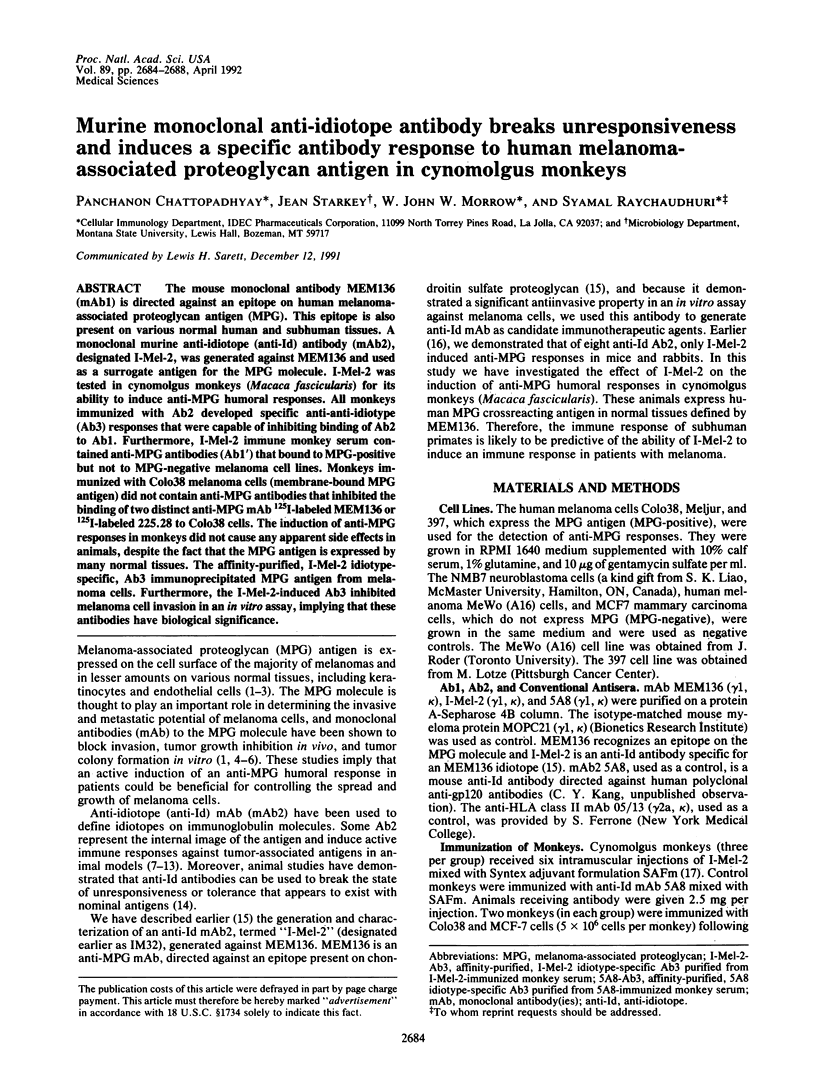
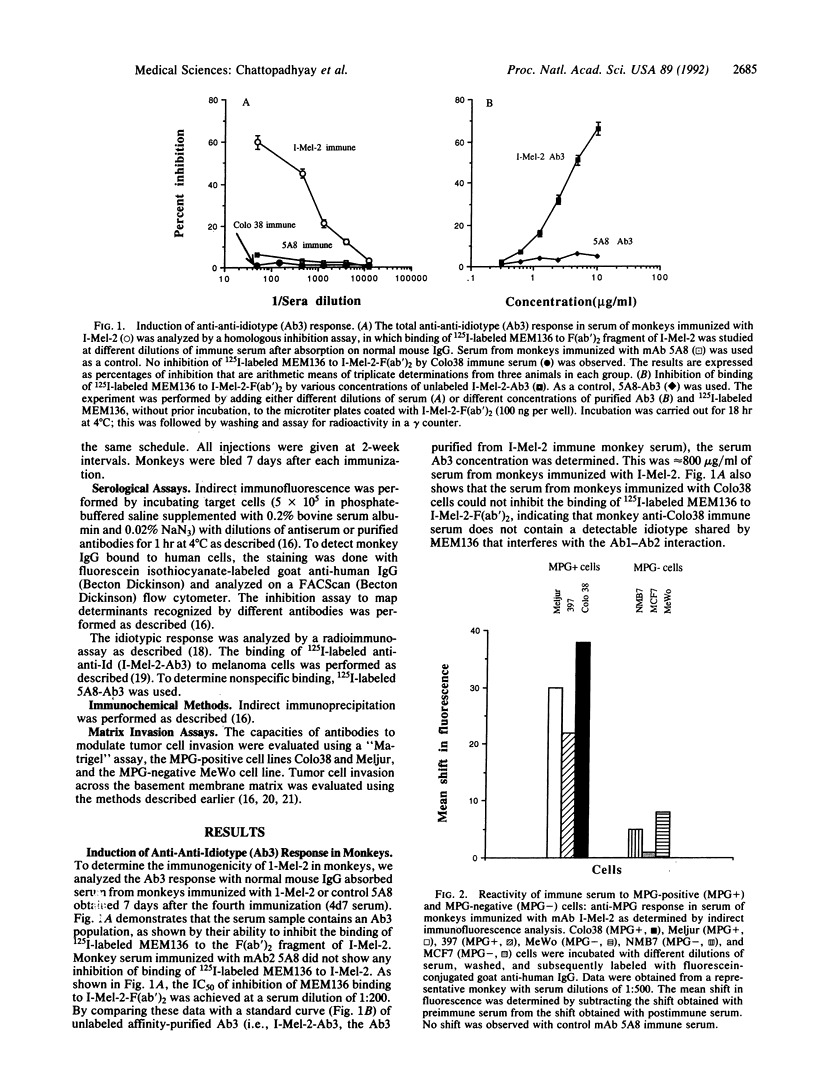
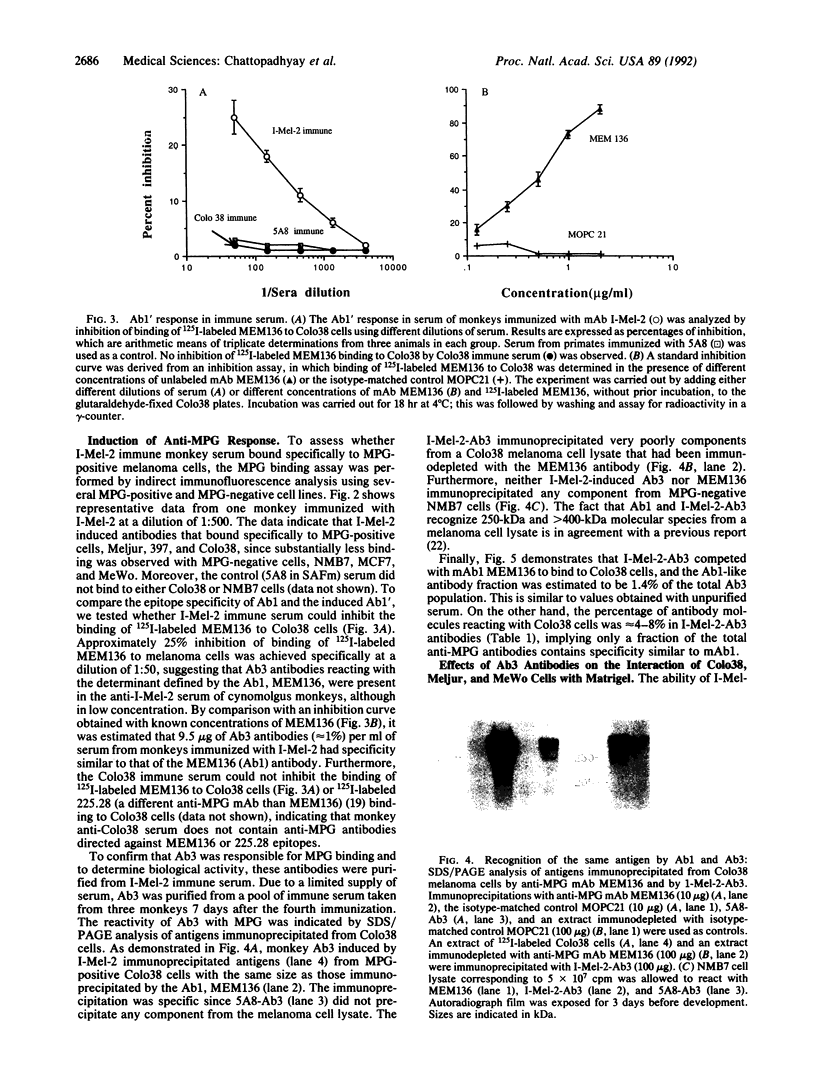
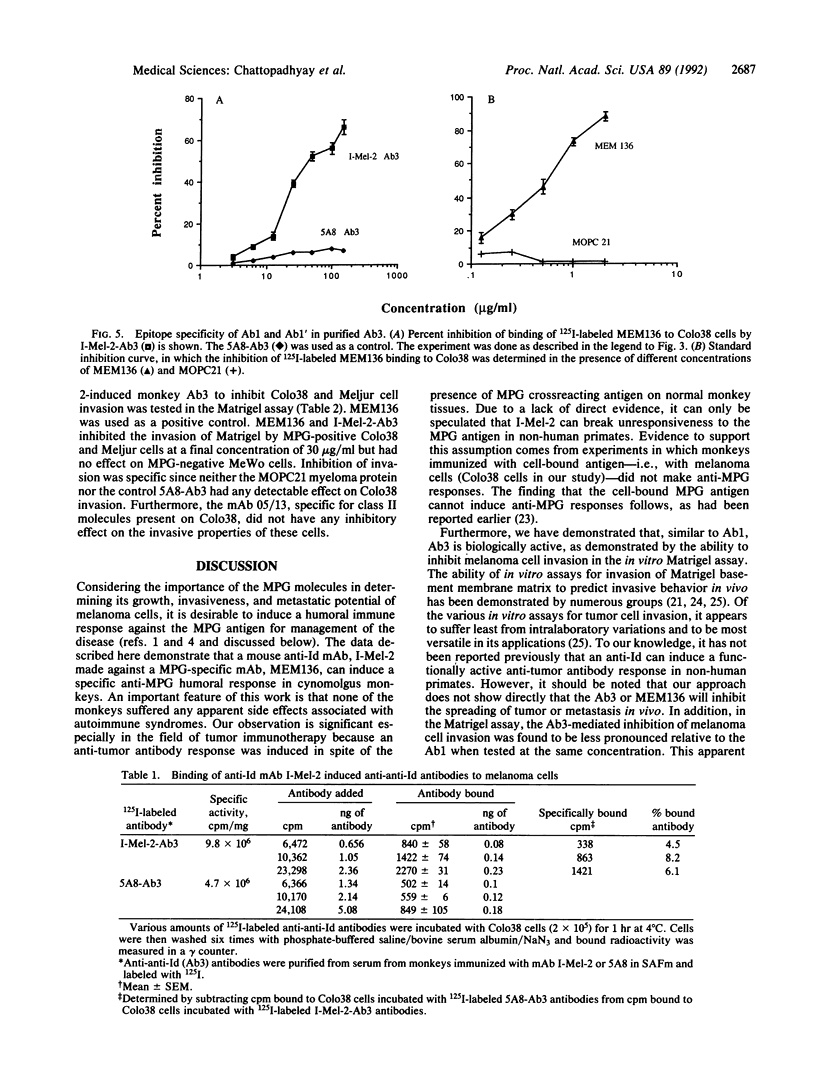
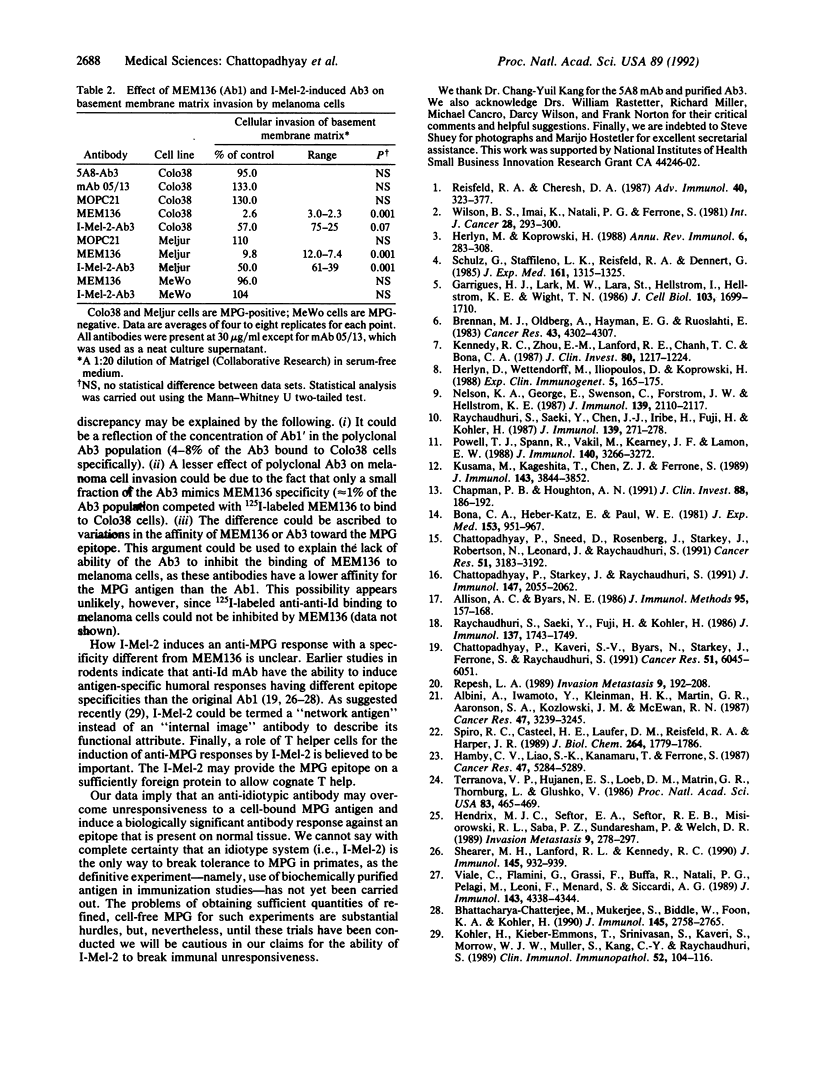
Images in this article
Selected References
These references are in PubMed. This may not be the complete list of references from this article.
- Albini A., Iwamoto Y., Kleinman H. K., Martin G. R., Aaronson S. A., Kozlowski J. M., McEwan R. N. A rapid in vitro assay for quantitating the invasive potential of tumor cells. Cancer Res. 1987 Jun 15;47(12):3239–3245. [PubMed] [Google Scholar]
- Allison A. C., Byars N. E. An adjuvant formulation that selectively elicits the formation of antibodies of protective isotypes and of cell-mediated immunity. J Immunol Methods. 1986 Dec 24;95(2):157–168. doi: 10.1016/0022-1759(86)90402-3. [DOI] [PubMed] [Google Scholar]
- Bhattacharya-Chatterjee M., Mukerjee S., Biddle W., Foon K. A., Köhler H. Murine monoclonal anti-idiotype antibody as a potential network antigen for human carcinoembryonic antigen. J Immunol. 1990 Oct 15;145(8):2758–2765. [PubMed] [Google Scholar]
- Bona C. A., Heber-Katz E., Paul W. E. Idiotype-anti-idiotype regulation. I. Immunization with a levan-binding myeloma protein leads to the appearance of auto-anti-(anti-idiotype) antibodies and to the activation of silent clones. J Exp Med. 1981 Apr 1;153(4):951–967. doi: 10.1084/jem.153.4.951. [DOI] [PMC free article] [PubMed] [Google Scholar]
- Brennan M. J., Oldberg A., Hayman E. G., Ruoslahti E. Effect of a proteoglycan produced by rat tumor cells on their adhesion to fibronectin-collagen substrata. Cancer Res. 1983 Sep;43(9):4302–4307. [PubMed] [Google Scholar]
- Chapman P. B., Houghton A. N. Induction of IgG antibodies against GD3 ganglioside in rabbits by an anti-idiotypic monoclonal antibody. J Clin Invest. 1991 Jul;88(1):186–192. doi: 10.1172/JCI115276. [DOI] [PMC free article] [PubMed] [Google Scholar]
- Chattopadhyay P., Kaveri S. V., Byars N., Starkey J., Ferrone S., Raychaudhuri S. Human high molecular weight-melanoma associated antigen mimicry by an anti-idiotypic antibody: characterization of the immunogenicity and the immune response to the mouse monoclonal antibody IMel-1. Cancer Res. 1991 Nov 15;51(22):6045–6051. [PubMed] [Google Scholar]
- Chattopadhyay P., Sneed D., Rosenberg J., Starkey J., Robertson N., Leonard J., Raychaudhuri S. Monoclonal anti-idiotypic antibodies to human melanoma-associated proteoglycan antigen: generation and characterization of anti-idiotype antibodies. Cancer Res. 1991 Jun 15;51(12):3183–3192. [PubMed] [Google Scholar]
- Chattopadhyay P., Starkey J., Raychaudhuri S. Analysis of anti-tumor antibodies in mice and rabbits induced by monoclonal anti-idiotope antibodies. J Immunol. 1991 Sep 15;147(6):2055–2062. [PubMed] [Google Scholar]
- Garrigues H. J., Lark M. W., Lara S., Hellström I., Hellström K. E., Wight T. N. The melanoma proteoglycan: restricted expression on microspikes, a specific microdomain of the cell surface. J Cell Biol. 1986 Nov;103(5):1699–1710. doi: 10.1083/jcb.103.5.1699. [DOI] [PMC free article] [PubMed] [Google Scholar]
- Hamby C. V., Liao S. K., Kanamaru T., Ferrone S. Immunogenicity of human melanoma-associated antigens defined by murine monoclonal antibodies in allogeneic and xenogeneic hosts. Cancer Res. 1987 Oct 15;47(20):5284–5289. [PubMed] [Google Scholar]
- Hendrix M. J., Seftor E. A., Seftor R. E., Misiorowski R. L., Saba P. Z., Sundareshan P., Welch D. R. Comparison of tumor cell invasion assays: human amnion versus reconstituted basement membrane barriers. Invasion Metastasis. 1989;9(5):278–297. [PubMed] [Google Scholar]
- Herlyn D., Wettendorff M., Iliopoulos D., Koprowski H. Functional mimicry of tumor-associated antigens by antiidiotypic antibodies. Exp Clin Immunogenet. 1988;5(4):165–175. [PubMed] [Google Scholar]
- Herlyn M., Koprowski H. Melanoma antigens: immunological and biological characterization and clinical significance. Annu Rev Immunol. 1988;6:283–308. doi: 10.1146/annurev.iy.06.040188.001435. [DOI] [PubMed] [Google Scholar]
- Kennedy R. C., Zhou E. M., Lanford R. E., Chanh T. C., Bona C. A. Possible role of anti-idiotypic antibodies in the induction of tumor immunity. J Clin Invest. 1987 Nov;80(5):1217–1224. doi: 10.1172/JCI113195. [DOI] [PMC free article] [PubMed] [Google Scholar]
- Kusama M., Kageshita T., Chen Z. J., Ferrone S. Characterization of syngeneic antiidiotypic monoclonal antibodies to murine anti-human high molecular weight melanoma-associated antigen monoclonal antibodies. J Immunol. 1989 Dec 1;143(11):3844–3852. [PubMed] [Google Scholar]
- Köhler H., Kieber-Emmons T., Srinivasan S., Kaveri S., Morrow W. J., Müller S., Kang C. Y., Raychaudhuri S. Revised immune network concepts. Clin Immunol Immunopathol. 1989 Jul;52(1):104–116. doi: 10.1016/0090-1229(89)90197-9. [DOI] [PubMed] [Google Scholar]
- Nelson K. A., George E., Swenson C., Forstrom J. W., Hellström K. E. Immunotherapy of murine sarcomas with auto-anti-idiotypic monoclonal antibodies which bind to tumor-specific T cells. J Immunol. 1987 Sep 15;139(6):2110–2117. [PubMed] [Google Scholar]
- Powell T. J., Jr, Spann R., Vakil M., Kearney J. F., Lamon E. W. Activation of a functional idiotype network response by monoclonal antibody specific for a virus (M-MuLV)-induced tumor antigen. J Immunol. 1988 May 1;140(9):3266–3272. [PubMed] [Google Scholar]
- Raychaudhuri S., Saeki Y., Chen J. J., Iribe H., Fuji H., Kohler H. Tumor-specific idiotype vaccines. II. Analysis of the tumor-related network response induced by the tumor and by internal image antigens (Ab2 beta). J Immunol. 1987 Jul 1;139(1):271–278. [PubMed] [Google Scholar]
- Raychaudhuri S., Saeki Y., Fuji H., Kohler H. Tumor-specific idiotype vaccines. I. Generation and characterization of internal image tumor antigen. J Immunol. 1986 Sep 1;137(5):1743–1749. [PubMed] [Google Scholar]
- Reisfeld R. A., Cheresh D. A. Human tumor antigens. Adv Immunol. 1987;40:323–377. doi: 10.1016/s0065-2776(08)60242-4. [DOI] [PubMed] [Google Scholar]
- Repesh L. A. A new in vitro assay for quantitating tumor cell invasion. Invasion Metastasis. 1989;9(3):192–208. [PubMed] [Google Scholar]
- Schulz G., Staffileno L. K., Reisfeld R. A., Dennert G. Eradication of established human melanoma tumors in nude mice by antibody-directed effector cells. J Exp Med. 1985 Jun 1;161(6):1315–1325. doi: 10.1084/jem.161.6.1315. [DOI] [PMC free article] [PubMed] [Google Scholar]
- Shearer M. H., Lanford R. L., Kennedy R. C. Monoclonal anti-idiotypic antibodies induce humoral immune responses specific for simian virus 40 large tumor antigen in mice. J Immunol. 1990 Aug 1;145(3):932–939. [PubMed] [Google Scholar]
- Spiro R. C., Casteel H. E., Laufer D. M., Reisfeld R. A., Harper J. R. Post-translational addition of chondroitin sulfate glycosaminoglycans. Role of N-linked oligosaccharide addition, trimming, and processing. J Biol Chem. 1989 Jan 25;264(3):1779–1786. [PubMed] [Google Scholar]
- Terranova V. P., Hujanen E. S., Loeb D. M., Martin G. R., Thornburg L., Glushko V. Use of a reconstituted basement membrane to measure cell invasiveness and select for highly invasive tumor cells. Proc Natl Acad Sci U S A. 1986 Jan;83(2):465–469. doi: 10.1073/pnas.83.2.465. [DOI] [PMC free article] [PubMed] [Google Scholar]
- Viale G., Flamini G., Grassi F., Buffa R., Natali P. G., Pelagi M., Leoni F., Ménard S., Siccardi A. G. Idiotypic replica of an anti-human tumor-associated antigen monoclonal antibody. Analysis of monoclonal Ab1 and Ab3 fine specificity. J Immunol. 1989 Dec 15;143(12):4338–4344. [PubMed] [Google Scholar]
- Wilson B. S., Imai K., Natali P. G., Ferrone S. Distribution and molecular characterization of a cell-surface and a cytoplasmic antigen detectable in human melanoma cells with monoclonal antibodies. Int J Cancer. 1981 Sep 15;28(3):293–300. doi: 10.1002/ijc.2910280307. [DOI] [PubMed] [Google Scholar]



